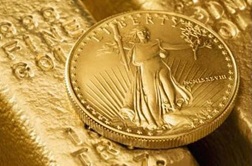Gold – Take It Easy
 The internet is filled with headlines that can drive us crazy and create worry, fear, and anxiety. The sound of our own wheels, as we travel through the economic, political, and financial jungle, can, indeed, drive us a little wacky. Will gold crash again? Will the controllers and manipulators manage another stock market swan dive? Will negative interest rates destroy the financial world as we know it? We dare not elect - fill in the blank. Bond prices? Derivatives crash? There are 1,001 more concerns…
The internet is filled with headlines that can drive us crazy and create worry, fear, and anxiety. The sound of our own wheels, as we travel through the economic, political, and financial jungle, can, indeed, drive us a little wacky. Will gold crash again? Will the controllers and manipulators manage another stock market swan dive? Will negative interest rates destroy the financial world as we know it? We dare not elect - fill in the blank. Bond prices? Derivatives crash? There are 1,001 more concerns…
To counter short-term anxiety and uncertainty, look at the long term – say 50 years. What have gold and the Dow Jones Industrial Average done over 50 years and what do they tell us about the next 5 years?
Graph 1: The DJIA over 50 years on a log scale.
- The DJIA has risen exponentially and is approximately on the trend line.
- There was a nasty crash in 2000 and another in 2008. Look out below!
Graph 2: The official U.S. National Debt over 50 years on a log scale.
- Official national debt increased exponentially over the last 50 years. A graph since 1913 is similar. The national debt has increased about 9% per year, every year, since 1913. Expect it to continue and accelerate in the current craziness of “bail everyone out, give me lots of free stuff, never saw a war we didn’t like, never saw a currency printing press that couldn’t run faster…”
- The debt will increase in the US, Europe, Japan and essentially everywhere that central banks run the show.
- Of course, we all know exponential increases can’t last forever, but central bankers, politicians, and economies will die trying.
Yes, gold prices increase exponentially driven by the devaluation of unbacked fiat currencies, deficit spending, and debt, more debt, and, incredibly, more debt.
How do we make sense out of the last fifty years? Over 50 years, the DJIA has been priced approximately 12 times larger than gold, on average. Graph the sum of the DJIA and 12 times the price of gold in “funny money” US Dollars – on a log scale.
Graph 3: The sum of the DJIA and 12 times the price of gold in "funny money" U.S. dollar - on a log scale
- As expected, the sum has increased exponentially.
- A spike occurred in 1979-1980 when gold zoomed higher in a bubble. All bubbles (such as bonds in 2016) collapse, and the sum dropped back on trend.
- Commentators often claim that gold prices were in a bubble in 2011, but prices were NOT in a bubble like they were in 1980. Another bubble in gold and silver prices will come.
- The sum is currently at the lower end of the 50-year log-scale trend line, even with the DJIA near all-time highs. Gold has considerable room to run higher, even without a 1980 style blow-off in price.
- The exponential trend channel rises about 2.6% per year less rapidly than the national debt over 50 years.
Graph 4: Graph the 50-year sum of gold and the DJIA, boosted by 2.6% each year, and divided by the official U.S. national debt.
- The ratio has been, essentially, constant for 50 years.
- The 1980 bubble in gold prices is clearly visible.
- The 2011 non-bubble in gold prices is clearly visible.
Conclusions
- We live in an exponential world. Gold, the DJIA, their sum, and debt have increased exponentially for 50 (and more) years. Expect the trends to continue.
- Official national debt has increased, on average, 2.6% per year more rapidly than the sum of gold + the DJIA for 50 years.
- A 50-year trend of increasing debt and prices is not likely to materially change short of nuclear war, a global economic collapse, or the arrival of honest and responsible politicians.
- Expect much more debt – it has successfully created wealth for the financial and political elite since 1913.
- Along with exponentially more debt, expect exponentially higher gold prices and higher DJIA. Expect volatility and corrections.
What About Gold In The Future?
We should expect the exponential trends to continue. Debt creation will probably accelerate. The DJIA is due for a swan dive to another seven- or eight-year low. The high – so it looks now – occurred in mid-2015.
The high trend line for the sum of the DJIA and 12-times gold reaches approximately 90,000 in 2020 – 2022. Assume the DJIA corrects lower and climbs again to 20,000 in the next few years, thanks to central bank emergency levitation procedures. Gold prices could be $6,000 per ounce in 2021.
Is this a prediction? Of course not! It suggests that gold prices are likely to rally, the DJIA is due for a correction, and the 50-year exponential trend puts gold prices in 2020 – 2022 in the range of $4,000 to $8,000.
Regarding higher gold prices, consider the insanity of negative interest rates, exponential debt, bond bubbles, central banks fully intending to devalue currencies and inflate consumer prices; potentially escalating war in Syria, Libya, and Ukraine; and election year promises of more “free stuff” to buy votes. Higher gold prices look both reasonable and inevitable. Fifty years ago gold sold for under $40. Gold selling for over $4,000 does not seem unlikely. Depending on the unfolding insanity in our political and financial world, $4,000 might be considered quite low in 5 – 10 years.
Take it easy. Look at the 50-year big picture. Don’t get lost in the daily and weekly political and financial distractions. Gold and silver were valuable long before central banks were created, and will remain valuable long after the world has returned to financial sanity. Take it easy while gold soars like an eagle.





 Gary Christenson is the owner and writer for the popular and contrarian investment site Deviant Investor and the author of the book, Gold Value and Gold Prices 1971 – 2021. He is a retired accountant and business manager, with 30 years of experience studying markets, investing, and trading. He writes about investing, gold, silver, the economy, and central banking.
Gary Christenson is the owner and writer for the popular and contrarian investment site Deviant Investor and the author of the book, Gold Value and Gold Prices 1971 – 2021. He is a retired accountant and business manager, with 30 years of experience studying markets, investing, and trading. He writes about investing, gold, silver, the economy, and central banking.














